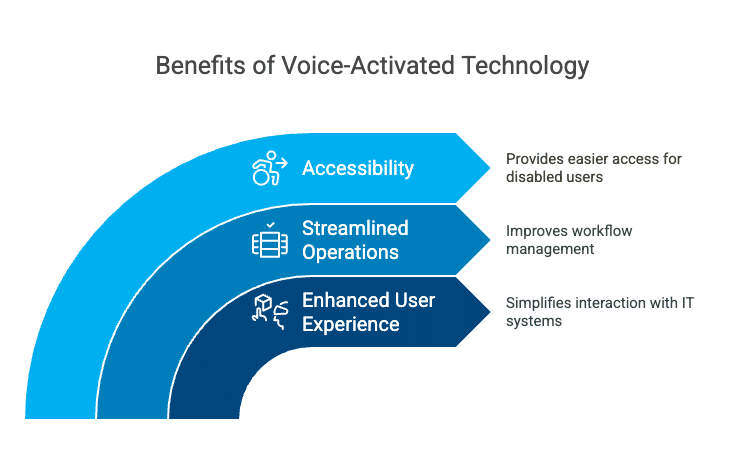Technology that uses voice control to function has integrated seamlessly into our lives and IT, changing the way we interact with devices and manage various tasks. Often seen as a harmless novelty, this technological development has far more potential than most realize. If harnessed correctly, voice-activation technology could become a powerful tool for your business.
What is Voice-Activated Technology?
As the name suggests, voice-activated technology is any technology that uses a combination of voice recognition (the ability to pick out a human voice from other sounds) and voice control (the ability to obey verbal commands) in order to operate. A good example of this in action is AI assistants like Siri and Alexa, which will wait for a verbal prompt and then act upon hearing it. This technology has many applications.
Applications and Benefits
Voice-activation technology has many uses in IT, across a wide range of fields.

Enhanced User Experience:
Voice-activated technology simplifies interaction with IT systems, by providing a more intuitive and natural user experience. Instead of having to navigate menus, users can simply speak commands. This is particularly useful in fields that require hands-free operation, such as healthcare and manufacturing.
Streamlined Operations:
Voice commands can streamline workflow management, by allowing employees to quickly access information, schedule meetings, and manage emails. All of this can be done without interrupting their work. This is very useful in environments that require multitasking.
Accessibility:
Another benefit is improved accessibility. Staff with certain disabilities may find it easier to use voice-activated technology. This makes it an attractive alternative to traditional input methods for many, fostering a more inclusive workplace and greater accessibility compliance for companies who choose to use it.
Innovation and Integration
Voice-activated software is being integrated with a variety of other technologies, which has led to exciting new developments. Some examples are:
Internet of Things (IoT):
Voice-activation and the IoT are a powerful combination. In workplaces, voice commands can now be used to control machinery, reducing the need to interact with potentially dangerous equipment.
Developments in Artificial Intelligence (AI):
While use of AI in voice-activated technology is well-established, new applications are always being found. During Covid19, voice recognition software was developed to screen patients. Technology like this could become invaluable in the future.
Voice Cloning:
The ability to falsify a person’s voice with machines is often seen as a tool for scammers, but there are positive applications as well. For example, a patient’s voice can be captured before it is lost due to surgery or disease. That voice can later be cloned, and used to help the patient speak again through devices.
Challenges and Considerations
As useful as it is, voice-activation technology comes with its own host of challenges. These are important to consider before implementing it into your business.
Security and Privacy:
In a society well aware of the dangers of data breaches, any new technology brings forth security and privacy concerns. Voice-activation devices often require continuous listening, in order to hear when a command is given – and this has created fear about unauthorized access.
When using this technology in your business, it is important to prioritize security. Encrypt voice data, educate users on best practices, and regularly update systems.
Ease-of-Use:
There are some issues that can impact ease-of-use in certain circumstances. For example, industries that commonly have lots of background noise may struggle to implement it, due to the device not understanding commands. This can also happen when an individual has an accent the device is not familiar with.
Developers continue to work on these issues, but there are mitigation methods you can use in the meantime. Try to use voice-activated technology in quieter areas if possible. Perform research on which devices are less likely to experience problems, before choosing one, and instruct personnel to speak loudly and clearly.
Internet Connectivity:
Many voice-activated devices require internet access in order to function, and this can present a problem in areas that do not have a consistent connection. This may make companies hesitant to fully integrate it, as they fear losing critical systems should the internet drop out.
Some strategies to help prevent this may include use of backup solutions, like hotspots, to ensure things run smoothly if internet connectivity is lost. There are also certain broadband providers who specialize in providing internet access to remote regions.
Transform Your Business with Voice-Activated Technology
The potential applications of voice-activated technology are vast. Industry-specific solutions aside, every company’s IT department could benefit from some of the more general software, resulting in increased efficiency and accessibility. If you are not currently using voice-activation, it may be time to consider whether you should.
Davenport Group specializes in empowering businesses to adopt new technology trends and stay ahead of the competition. Our team of experts know how to rebuild and reshape your business, so that you can move into the future without fear. Explore our digital transformation solutions to learn more.
